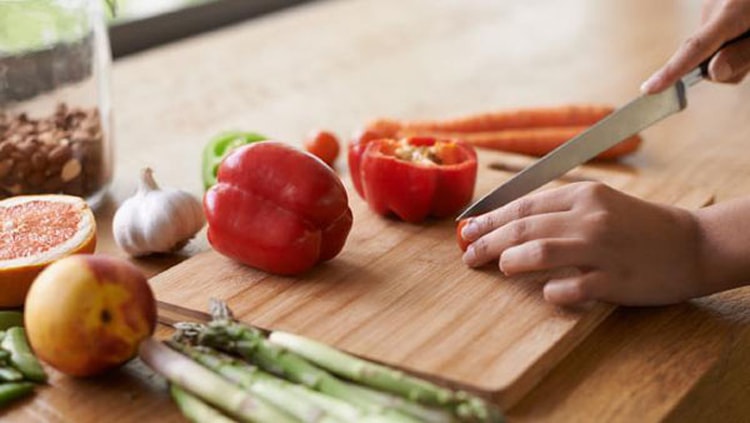The 'dirtiest guys' in the kitchen that you never thought of
In the kitchen, the dirtiest thing is the dishcloth, the longer it is used, the more bacteria it has.
Dishcloth
In the kitchen, the dirtiest thing is the dishcloth. There are about 10 million bacteria per square meter with a sponge cloth and about a million with a cloth cloth. Among them are E. coli and Salmonella (bacteria that make food toxic). These bacteria can stick to dishes, through food and into the body causing illness. When we use a dirty cloth, we cross-contaminate bacteria in the kitchen.
To maintain hygiene, after each dishwashing, the cloth should be thoroughly washed by hand or put in the washing machine with detergent. Then hang in a ventilated place to dry naturally.
The longer a dishcloth is used, the more bacteria it will accumulate. If possible, after washing it, put it in the microwave for 1-2 minutes. This will reduce the moisture of the cloth and kill any living bacteria.
|
For dishwashing cloths, you should use wood fibers or natural fibers that are not mixed with any chemical ingredients. Photo:elekanews. |
Do not use dishwashing cloths made of chemical fibers or steel because during the scrubbing process, thin steel fibers and chemical fibers can easily come off and stick to food. Once in the body, these ingredients are difficult to digest and can easily cause some intestinal diseases.
For dishwashing cloths, you should choose 100% wood fiber or natural fiber without any chemical ingredients. This type absorbs well, does not stick to grease when washing, and is easy to clean and wash away stains on kitchen dishes.
Chopsticks
Many people think that chopsticks should only be replaced when they are moldy or rotten. But the truth is not like that because chopsticks also have an expiration date and if they are expired, they are "invisible killers" that threaten human health.
Chopsticks that have been used for too long, of poor quality, often have a rough surface. This is where food easily sticks, if not cleaned properly, bacteria and mold will grow. The result is food poisoning, diarrhea caused by bacteria such as salmonella, escherichia coli, staphylococcus, clostridium botulinum. In addition, some toxic molds that infect chopsticks can produce the very toxic toxin aflatoxin, which is the cause of liver cancer.
To eliminate the above risks, before washing, soak the chopsticks in detergent for 1-2 minutes, then rinse them under running water. The next step is to put the chopsticks in a pot of water and boil for half an hour. This will eliminate harmful bacteria in the chopsticks. Finally, place the chopsticks in a dry, airy place. This method also applies to newly purchased chopsticks.
|
With bamboo and wooden chopsticks, the usage time should only last 3-6 months. Photo:gmw. |
Bamboo and wooden chopsticks only last 3-6 months, while metal chopsticks last longer. After this period, the color of the chopsticks may change to a darker or lighter color due to the frequency of use. Once the color has changed, the material will definitely change, which means the safety level has decreased and it is necessary to replace it with another pair of chopsticks.
If black spots appear on the surface of bamboo or wooden chopsticks, it means they are contaminated and should be discarded immediately. If the chopsticks have a distinct sour taste, do not hesitate to keep them, because they are contaminated.
Cutting board
Many families still have the habit of using the same cutting board for all cooking steps. After cutting raw meat or fish, they often wash it first and then cut vegetables and even cooked food.
According to experts, this is extremely dangerous because raw foods such as meat and fish contain many bacteria and parasites. If you use the same cutting board to cut both raw and cooked foods, these bacteria can easily stick to the food, easily causing poisoning and digestive diseases.
Knowing this, instead of buying two separate cutting boards, to save money, many families use two cutting boards at the same time. One side is for cutting raw food, the other side is for cutting cooked food. In fact, flat surfaces used to place cutting boards such as kitchen shelves and floors are often sources of contamination. When the cutting board is placed down, bacteria also stick to the underside of the cutting board. Therefore, each family should have two cutting boards, one for raw food and one for cooked food.
|
If you use one cutting board for all cooking steps, the risk of contamination is very high. Photo:Reader's Digest. |
After use, many people often just rinse the cutting board with water and then hang it up to dry. This will make them more susceptible to digestive diseases and poisoning.
To wash cutting boards properly, here are some suggestions.
+ Washing and disinfecting: First, wash the surface and crevices of the cutting board with a hard brush and detergent, then rinse with boiling water.
+ Disinfect with salt: Use a knife to scrape off the residue on the surface of the cutting board. Sprinkle a layer of salt on the surface then rub half a lemon on the cutting board. The cutting board will be clean and bacteria-free.
+ Disinfect with onion: Use onion or raw ginger to rub the cutting board surface several times. Then use a brush to clean. The final step is to rinse with boiling water.
+ Disinfect with vinegar: Mix vinegar and lemon juice in a 1:1 ratio and wipe the cutting board surface several times. Let the cutting board dry naturally in the sunlight. The final step is to rinse with water.





